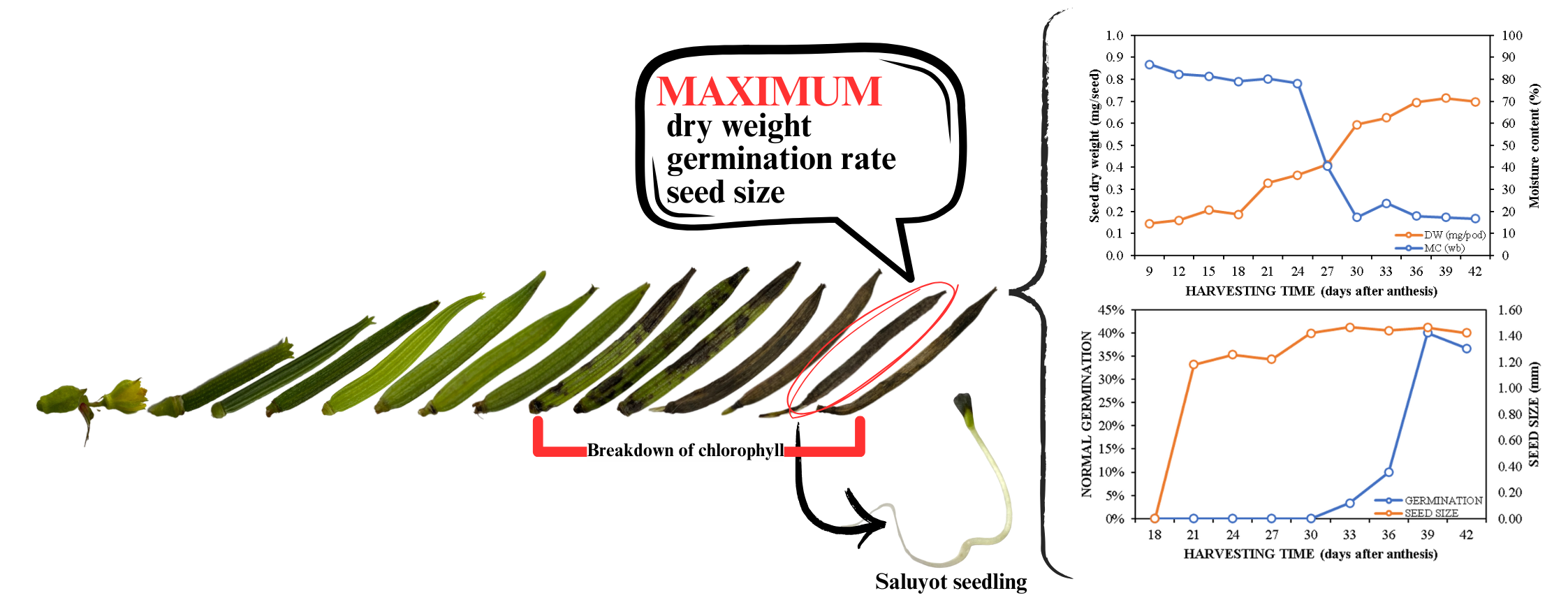
Marjun C. Alvarado
Graduate School, University of the Philippines Los Baños (UPLB), Laguna, Philippines
Arsenio D. Bulfa Jr.
Graduate School, University of the Philippines Los Baños (UPLB), Laguna, Philippines
Annalissa L. Aquino
Institute of Crop Science, College of Agriculture and Food Science, UPLB, Laguna, Philippines
DOI: https://doi.org/10.14456/apst.2025.4
Keywords: Saluyot saluyot seeds physiological maturity moisture content seed dry weight seed maturity seed science
Abstract
This paper explores the morphological and physiological changes in Saluyot seeds as they reach physiological maturity. The experiment encompassed the period from anthesis to physiological maturity, with observations conducted at three-day intervals. Monitored parameters included seed pod and seed color, size, seed moisture content, seed dry weight, and seed germination rate. The results indicate a gradual increase in seed size from 21 days after anthesis (AA) to 39 days AA, followed by a decline at 42 days AA, with average seed sizes ranging from 1.18 mm to 1.46 mm and 1.42 mm, respectively. Additionally, the color of the seeds and their pods gradually changes from green to the formation of black spots, signifying chlorophyll degradation. The moisture content (MC) of the seeds also decreases progressively from 9 days to 24 days AA, with a rapid loss recorded from 27 days to 42 days AA, averaging between 86.78% and 78.21%, and 40.54% to 16.64%, respectively. Regarding seed dry weight, the maximum weight was observed between 39- and 42-days AA, at 0.71 mg and 0.70 mg, respectively, indicating the physiological maturity of seeds within this period. Moreover, Saluyot seeds displayed a low germination rate, with a maximum of 40% observed on 39 days AA. This low germination rate suggests the onset of dormancy in Saluyot seeds post-harvest. In summary, the physiological maturity of seeds, as indicated by maximum seed dry weight and germination rate, occurs at 39 days AA.
How to Cite
Alvarado, M. C., Bulfa Jr., A. D., & Aquino, A. L. (2025). Evaluation of the morphological and physiological changes of Saluyot (Corchorus olitorius) during seed maturation. Asia-Pacific Journal of Science and Technology, 30(01), APST–30. https://doi.org/10.14456/apst.2025.4
References
Bareke T. Biology of seed development and germination physiology. Adv Plants Agric Res. 2018;8(4):1-11.
Sripathy KV, Groot SP. Seed development and maturation. Dadlani M, Yadava DK, editors. Seed science and technology: Biology, production, quality. Singapore, Singapore: Springer; 2023. p. 17-38.
Delouche JC. Determinants of seed quality. Mississippi: Seed Technology Laboratory, Mississippi State University; 1971. p 53-89.
Berti MT, Johnson BL, Manthey LK. Seed physiological maturity in Cuphea. Ind Crops Prod. 2007;25(2):190–201.
Biswas A, Dey S, Huang S, Deng Y, Birhanie ZM, Zhang J, et al. A Comprehensive review of C. capsularis and C. olitorius: A source of nutrition, essential phytoconstituents and pharmacological activities. Antioxidants. 2022;11(7):1358.
Steyn NP, Olivier J, Winter P, Burger S, Nesamvuni C. A survey of wild, green, leafy vegetables and their potential in combating micronutrient deficiencies in rural populations : Research in action. South Afr J Sci. 2001;97(7):276–278.
Biswas A, Dey S, Li D, Liu Y, Zhang J, Huang S, et al. Comparison of phytochemical profile, mineral content, and In Vitro antioxidant activities of Corchorus capsularis and Corchorus olitorius leaf Extracts from different populations. J Food Qual. 2020;2020(1):2931097.
Mahakur VK, Bhowmik S, Patowari PK. Decision making approaches for recognizing the optimal alkalized Corchorus olitorius powder based composites for sustainable applications. Phys Scr. 2023;98(12):125308.
Mahakur VK, Bhowmik S, Patowari PK. Impact of silanization on the characterization of Corchorus olitorius particle-based composites for sustainable applications. Polym Int. 2024;73(4):270–279.
Abbas AH, Serikov G, Zhuniskenov Y, Eghtesadi N, Bou-Hamdan KF, Pham TT. Investigation of natural mucilage for enhanced oil recovery: The potential of Corchorus olitorius hydrocolloid. ACS Omega. 2023;8(32): 29693–29703.
Bulfa AJ, Alvarado M, Aquino A. Evaluation of the morphological and physiological changes of Okra (Abelmoschus esculentus) during seed maturation. In: Proceedings of International Exchange and Innovation Conference on Engineering & Sciences (IEICES); 2024 Oct 17-18; Fukuoka, Japan: Kyushu University; 2024. p. 74–78.
Alvarado M, Bulfa AJ, Aquino A. Ultrasonic influence on germination and early growth of bell pepper seeds. In: Proceedings of International Exchange and Innovation Conference on Engineering & Sciences (IEICES); 2024 Oct 17-18; Fukuoka, Japan: Kyushu University; 2024. p. 19–25.
Cruz JM, Alves E, Farias O, Araujo P, Oliveira A. Physiological maturity and determination of the harvest time of Vigna unguiculata L. Walp. J Exp Agric Int. 2019;34(2):1–8.
Dante RA, Larkins BA, Sabelli PA. Cell cycle control and seed development. Front Plant Sci. 2014;5:493.
Kelly KM, Van Staden J, Bell WE. Seed coat structure and dormancy. Plant Growth Regul. 1992;11(3):201–209.
Kak A, Pandey C, Gupta V, Bhardwaj M, Dashora K. Effect of sulphuric acid pretreatment on breaking hard seed dormancy in diverse accessions of four wild Corchorus species. Seed Sci Technol. 2009;37:568–572.
Bewley J. Seed germination and dormancy. Plant Cell. 1997;9(7):1055–1066.
Bera A, Mukhopadhyay E, Kar CS, Kumar M, Bhandari HR. Efficacy of scarification treatments on release of seed coat imposed dormancy in five wild species of genus Corchorus. South Afr J Bot. 2020;135:144–147.
Velempini P, Riddoch I, Batisani N. Seed treatments for enhancing germination of wild okra (Corchorus olitorius). Exp Agric. 2003;39(4):441–447.
Maina FNW, Muasya RM, Gohole LS. Dormancy breaking in jute mallow (Corchorus olitorius) Seeds. Seed Technol. 2011;33(2):147–154.
Egli DB. The role of seed in the determination of yield of grain crops. Aust J Agric Res. 2006;57(12):1237–1247.
Yuliandira NP, Permatasari OSI, Ilyas S. Determination of seed physiological maturity of Ipomoea reptans poir. Based on Phenology, Seed Quality, and Heat Unit Accumulation. In: Proceedings of the International Symposium Southeast Asia Vegetable 2021 (SEAVEG 2021). Dordrecht: Atlantis Press International; 2022. p. 336–347.

Published:
License
This work is licensed under a Creative Commons Attribution-NonCommercial-NoDerivatives 4.0 International License.
